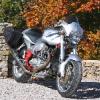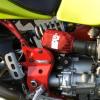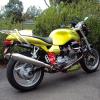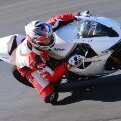Leaderboard
Popular Content
Showing content with the highest reputation on 07/09/2025 in all areas
-
To make your bike more visible to other road users consider adding a pair of LED driving lights I added a pair of these to my V7III Special $40 each https://www.superbrightleds.com/led-light-pod-2-modular-led-off-road-work-light-10w-900-lumens The nice thing about LEDs they normally give out full brightness from 9 Volts on up so you can lose a Volt you can't afford to lose with an incandescent lamp These lights come with an integral cable about a foot long so you may not need the optional wiring Harness.2 points
-
Well, I guess I shouldn't tell you I have two of them, but I always like to see how much comes out.2 points
-
The TPS voltage change is not an exponential curve but a straight line. Depending on the model of TPS it is either a dead straight line from zero degrees to 87 or a straight line until a break point at 30 deg then another straight line from there. So either the linier or non linier version. Just change the throttle bushes and seals. Delaying replacing the coated bushes will just end up wearing the throttle shafts and then the TB's are scrap unless you have the kind of access to machinery I have. Use the Viton seals now available via CA cycleworks as they will be better than the yamaha seals I'm sure. Phil2 points
-
This might help someone. (and apologies if it has already been noted) I had carefully set the TPS by the book and the bike (2002 LeMans) suffered from surging when hot and abrupt on/off throttle transition and slight pinking at full throttle. The surging and throttle transition made the bike frustrating to ride. I retested the TPS it was still 160mV with throttle plate closed = not significantly different than where I'd set it last year. I then noticed that when the throttle was pulled open that the first motion was to take up throttle shaft wear. (to check for wear, grab the throttle shaft nut under the throttle body and move it side to side. The right side has more play that the left, perhaps because of the return spring. There are rubber seals on the shafts but may be unable to compensate for the wear or have failed after 23 years.) In one of the TPS discussions KiwiRoy suggested that because the voltage increase with rotation is not linear that the goal of setting the TPS was not so much to achieve precisely 150mV (or 157mV), but to make sure the setting was on the tail of voltage increase. I pictured the voltage increase as a curve similar to exponential growth with 150mV somewhere close to the baseline suggesting that at 150mV the computer can sense the TPS but is not yet altering fuel settings. After setting the TPS the manual states that throttle plate angle should be set to 3-3.5 degrees. I wondered how to do this because I don't have Guzzidiag computer setup, but another post (I forget who posted) stated that throttle plate angle at idle corresponded to 470-480mV. Another post stated that instructions for installing a new mixture map that the idle throttle stop should be set at exactly 475mV. My idle stop was at 311mV so I decided to experiment with changing it. I set the TPS to show about 470mV just as the throttle starts to lift off the idle stop. As the throttle linkage is pulled the first movement takes up play in the worn throttle shaft and the mV increases. All the play is taken up and the throttle starts to open at about 470mV but my TPS reads about 420mV when the spring holds the throttle against the idle stop. (differing amounts of wear should result in different idle stop mV) With the throttle plate fully closed (as in setting by the book) the TPS shows about 220mV. I then balanced throttle bodies side to side. The result is dramatic! There is no hint of surging even at low rpm and low speed and the harsh on/off throttle transition is mostly gone. There is no pinking. It has really improved the bike. Yes, I know there someone has posted a tutorial for replacing throttle shaft bushings. I have even bought new bushings and seals and will get to it eventually, but I am very happy with the way the bike runs now.1 point
-
I guess because things don't necessarily change in a linier manner. It's all a bit of a moot point anyway as you should always aim for a few basic parameters which are. 1 choose a group 4 or 5 genuine synthetic oil 2 choose the lowest "W" grade you can get (mindful of #4) 3 Chose the "hot" grade that suits your operating environment. Commuting, OAT, track days, racing, hot weather two up touring etc. 4 Minimise the grade spread to "30"preferably to minimise the percentage of viscosity improvers in the oil. My Supra with the BMW engine got the 0W-20 dumped at the 1000klm oil change and in went the 5W-30 because I prefer to consider engine wear over meeting mandated fuel economy targets Phil PS here's another thing. Manufacturers often have esp 25 years ago product deals with oil companies and recommend/specify their particular oil products. Sometimes the deals swap to other oil manufacturers and the motorcycle manufacturers oil grade requirements are adjusted to reflect what the new/latest oil manufacture makes viscosity wise.1 point
-
Changes in how the motor vehicle industry has been challenged to reduce emissions. Thinner oil = less friction = less fuel consumption over an entire fleet of a manufacturers' vehicle range. Basically the same "thinking" that gave us "lifetime" lubricants and "the computer will tell you when to change oil" aka: vastly extended change intervals to show the world how a particular range of vehicles is reducing consumption and waste. Certainly, this "engineering" has been mindful of the warranty period. Others have a more technical and informed view of the matter. I was just "in a mood" and there is my1 point
-
I would also check that you're not losing Voltage through a dirty ignition switch that happened to my VII Sport cleaning and re-lubing the switch fixed that.1 point
-
Yes, make sure your main ground is good, typically it runs to a 6mm bolt at the rear of the gearbox The regulator also needs to be well grounded, i prefer that to be a short jumper to a timing cover screw rather than back to the battery. I think we figured that this picture was the result of a bad main ground,. On starting the starter current 100+ Amps tried to get back to the battery via the small wire between the regulator case and battery Negative the massive engine and gearbox castings are a better path than a wimpy copper wire. Better that the starter doesn't work than frying the loom.1 point
-
It is interesting to note that the later "CARC" set-up indexes the TPS with the throttle bodies seated on the factory pre-set idle stop (The Sacred Screw) in "similar fashion" to @Doansci's approach. Using the V11 "completely closed" index is curious since, once the linkage is hooked up and the idle set, the ECU never sees any values below the idle setting. It is simply the established method to index the map to the physical throttle opening through the rest of the range to WOT. Can the same indexing be achieved using the throttle angle at idle and the TPS at "some" mV? Sure, but it is going to be hit or miss. Seems @Doansci got a hit! (YMMV) P.S. - I am due a fresh Decent Tune-up and will pay attention to where my throttle degrees opening and mV end up at idle . . .1 point
-
Started my "shakedown/prep" for the XXI South'n SpineRaid, about two months out (metric: 8,6 weeks ). Sixty mile/97 km warm-up ride (aka: get beer). Onto the lift and drop motoroil and gearbox oil. No metal fuzz on the engine drain plug (6300 miles/ 10.000 km); the "usual" fuzz on the gearbox plug (15,000 miles/24.000 km). Out with the oil filter through the access cover, remove the label from the new WIX filter and see that the old filter gasket came out with the old filter. Fresh RedlIne 20W-50 after being certain the filter access cover screwed back on perfectly. Took time to troubleshoot the (lately) dodgy Neutral Switch. Fitted a new crush washer (to space the switch correctly on the shift plate) and adjusted the external shift mechanism connecting rod so the lever clears the Frame Side Plate/"stiletto" on the downstroke. On to service all major electrical grounds and battery terminals with CRC Electronics Cleaner® and Caig DeOxit®. Yeah, that's a French medical graduated cylinder. Yeah, I use that to add 850.0 ml to the gearbox. Yeah, I know that's bogus. I even heated the gear oil to 120ºF/ 49ºC for a clean pour. Next: Decent Tune-up . . .1 point
-
My Tenni has been back with me a week and running smoothly after its sojourn in Bungendore. Can’t praise Michael of Moto Moda enough. With help from Pete Roper they replaced my cracked (oem) aluminium flywheel and clutch with a RAM assembly. Just in time apparently with the 24 year old flywheel cracked to billy-Oh! For the non Aussies this basically means it was f…ed according to Mr Roper! While apart Michael attended to a few leaks, valves, replaced the shift spring as a preventative and then gave the bike a tune. Moto Moda is a pleasant 3 hours South West of Sydney so definitely consider these guys to keep these ageing bikes in fine fettle.1 point
-
This is how my 04 Ballabio sings to me about being Special and demanding my Attention1 point
-
Many find 0.006/0.008 a better set-up, so your intake was really not that far off. My sidestand wiring has a little zip-tie that gathers it, loosely, to the cover mount. I would love to see some 3D printed eagle medallions. Years ago, @sp838 made some with the Gambalunghino eagle.1 point





.thumb.jpg.d6290ab019918b498b79a6755957e33d.jpg)
